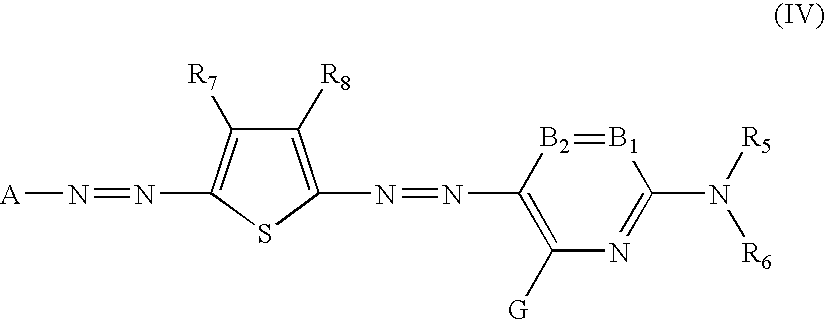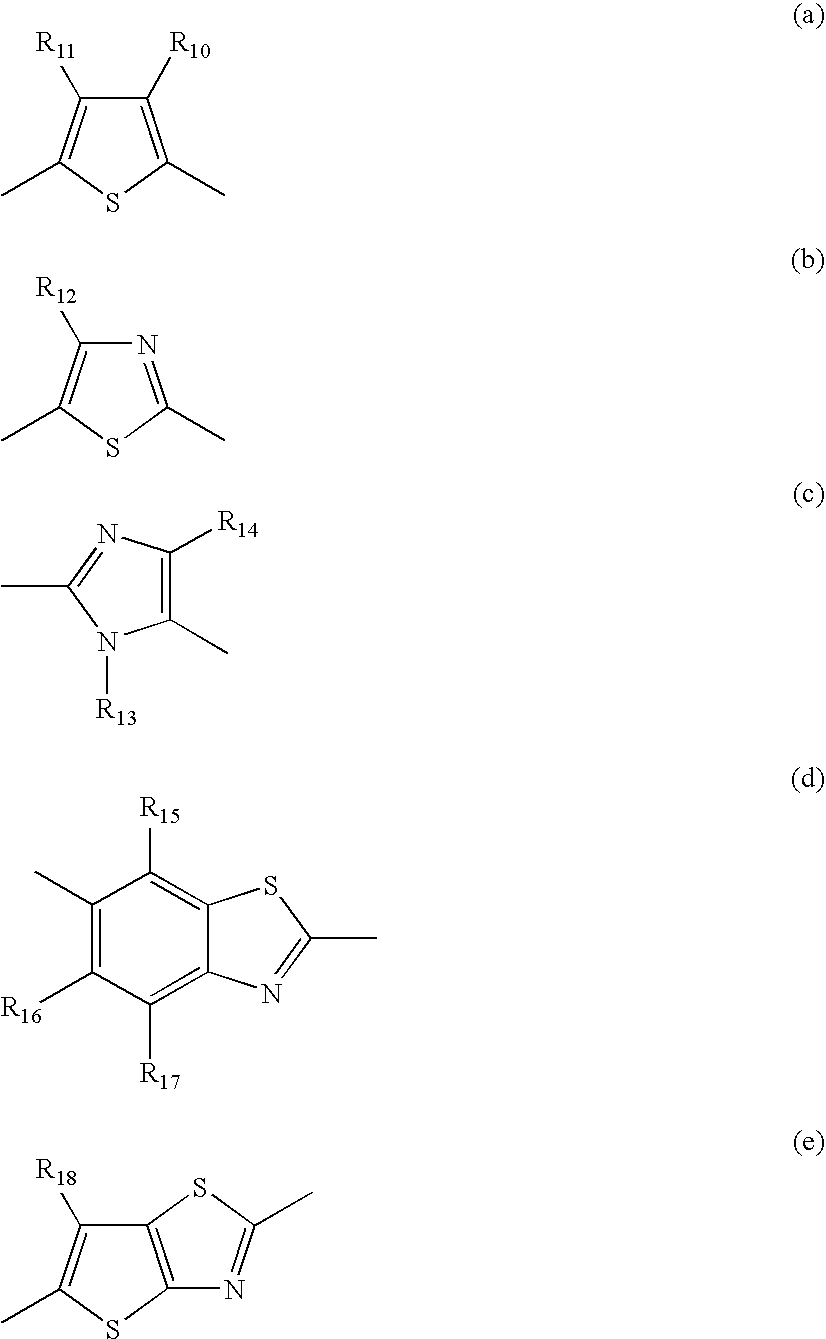[0101] An ink composition, for example an inkjet recording ink composition can be prepared by dissolving and / or dispersing the abovementioned specific azo compound in a lipophilic medium or an
aqueous medium. Preferably, an
aqueous medium is used. As required, the other additives are incorporated within a range where the effects of the invention are impaired. Examples of the other additives include known additives such as a
drying inhibitor (a
wetting agent), a
emulsion stabilizer, a penetration accelerator, a
ultraviolet ray absorber, a
fading-preventing agent, an anti-
fungal agent, a pH
regulator, a
surface tension regulator, an antifoaming agents, a
preservative, a
viscosity regulator, a dispersing agent, a dispersion stabilizer, a
rust proofing agent, a chelating agent, and the like. In the case of water-soluble ink, these various additives are directly added to the ink liquid. In the case that an oil-soluble dye is used in a dispersion form, the additives are generally added to a dye dispersion after its preparation but they may be added to an oily phase or an aqueous phase at the preparation.
[0102] The
drying inhibitor is suitably used for the purpose of preventing clogging of an ink
injection port of a
nozzle to be used in the inkjet recording mode, the clogging being caused by
drying of the inkjet recording ink.
[0103] The drying inhibitor is preferably a
water soluble organic solvent having a
vapor pressure lower than water. Specific examples thereof include polyhydric alcohols represented by
ethylene glycol,
propylene glycol,
diethylene glycol,
polyethylene glycol,
thiodiglycol, dithiodiglycol, 2-methyl-1,3-
propanediol, 1,2,6-hexanetriol,
acetylene glycol derivatives, glycerin, trimethylol
propane, and the like; lower
alkyl ethers of polyhydric alcohols, such as
ethylene glycol monomethyl (or monoethyl)
ether,
diethylene glycol monomethyl (or monoethyl)
ether,
triethylene glycol monoethyl (or monobutyl)
ether or the like; heterocyclic compounds such as 2-pyrrolidone, N-methyl-2-pyrrolidone, 1,3-dimethyl-2-
imidazolidinone, N-ethylmorpholine and the like;
sulfur-containing compounds such as
sulfolane, dimethylsulfoxide, 3-sulfolene and the like; polyfunctional compounds such as
diacetone alcohol,
diethanolamine, and the like; and
urea derivatives. Of these, polyhydric alcohols such as glycerin,
diethylene glycol and the like are more preferable. The drying inhibitor may be used singly or two or more of them may be used in combination. The drying inhibitor is preferably contained in the ink is in an amount of 10 to 50% by
mass.
[0104] The penetration accelerator is preferably used for the purpose of better penetration of the inkjet ink into paper. As the penetration accelerator, alcohols such as
ethanol, isopropanol,
butanol, di(tri)
ethylene glycol monobutyl ether, 1,2-hexanediol and the like;
sodium lauryl
sulfate,
sodium oleate, nonionic surfactants, and the like can be used. When the penetration accelerator is contained in the ink in an amount of 5 to 30% by
mass, sufficient effects are usually exhibited, and it is preferable to use it within a range where bleeding of the printed characters or print-through do not occur.
[0105] The
ultraviolet ray absorber is used for the purpose of enhancing the storability of images. As the
ultraviolet ray absorber,
usable are the
benzotriazole-based compounds described in JP-A-58-185677, JP-A-61-190537, JP-A-2-782, JP-A-5-197075, JP-A-9-34057, and the like; the
benzophenone-based compounds described in JP-A-46-2784, JP-A-5-194483, U.S. Pat. No. 3,214,463 and the like; the
cinnamic acid-based compounds described in JP-B-48-30492 (the term “JP-B” as used herein means an “examined Japanese patent publication”.) and JP-B-56-21141, JP-A-10-88106 and the like; the
triazine-based compounds described in JP-A-4-298503, JP-A-8-53427, JP-A-8-239368, JP-A-10-182621, JP-W-8-501291 (the term “JP-W” as used herein means a “published Japanese translation of a PCT
patent application”.), and the like; compounds described in Research Disclosure No. 24239; and compounds that absorb ultraviolet ray and emit
fluorescent light, so-called fluorescent brightening agents, represented by stilbene-based compounds and benzooxazole-based compounds.
[0106] The
fading-preventing agent is used for the purpose of enhancing the storability of images. As the
fading-preventing agent, various organic or
metal complex-based fading-preventing agents can be used. Examples of the organic fading-preventing agents include hydroquinones, alkoxyphenols, dialkoxyphenols,
phenols, anilines, amines, indanes, chromans, alkoxyanilines, heterocyclic compounds, and the like. Examples of
metal complex fading-preventing agents include
nickel complexes,
zinc complexes, and the like. Concretely, there can be used compounds described in the patents cited in Research Disclosure No. 17643 Chapter VII, items I to J, ibid., No. 15162, ibid., No. 18716, page 650, left column, ibid., No. 36544, page 527, ibid., No. 307105, page 872, ibid., No. 15162; compounds falling within the general formulas of representative compounds and compound examples described in JP-A-62-215272, pages 127 to 137.
 Login to View More
Login to View More  Login to View More
Login to View More 


